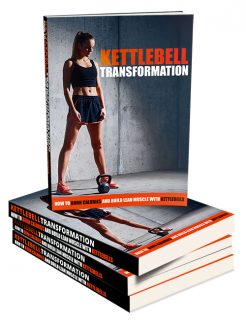 License Type: Master Resell Rights
License Type: Master Resell Rights  File Type: ZIP
File Type: ZIP
 SKU: 59559
SKU: 59559  Shipping: Online Download
Shipping: Online Download
Ebook Sample Content Preview:
Introduction
Right now, kettlebells are one of the big health fads that have everyone talking. Just about every fitness magazine and website seems to be advocating the use of kettlebells and they’re showing up in a ton of gyms where they never were before.
Is this just another health craze that will fade over time? Or is there something more to it?
The reality is that kettlebells are a small part of a much broader movement. A movement movement.
Suddenly, gym bros are going out of style as more freedom of information is helping us to get a better idea of what’s best for our bodies. We now know that you can’t fix a lifetime of sitting at a desk with 10 minutes of curling dumbbells. What’s missing from our lives is functional strength and mobility.
Simply put: we aren’t using our bodies the way that nature intended. And as a result, they’re starting to deteriorate much more quickly than they should. Cue the ‘Dad Bod’ – the infamous physique that plagues guys who spend 65 hours a week in the office, 20 in front of the TV, 10 in the pub and 2 in the gym.
We need to start over. We need to use more creative tools to make training fun again, to explore using our bodies and to start developing real-world strength that we can apply to our everyday lives. We need to become powerful, flexible and mobile again. And kettlebells can help you to do just that. Let’s explore what kettlebells are all about and why they represent such a paradigm shift.
In this book, you’ll learn how you can create an entire workout using just kettlebells. And this won’t be any old workout: this will be a workout that gives you the kind of body you always wanted along with the kind of performance you’ve only dreamed of. You’ll be stronger, faster, more adaptable and more energetic. You’ll feel more awake and even your brain will be supercharged beyond measure.
Don’t believe me? That’s fair enough – they’re bold claims. But I promise that once you’ve finished this book, you’ll understand exactly why that’s possible and exactly why you need to start kettlebell training today.
Chapter 1: An Introduction to the Kettlebell
So let’s start right at the beginning. What is a kettlebell? Where did it come from? And how do its unique properties make it such a truly effective training tool?
Essentially, the kettlebell is a small weight that can be used to provide external resistance in a manner very similar to a dumbbell. It has a handle and it comes in a range of different weights, allowing you to curl it or press it in just the same way.
The difference is in how the handle is positioned in relation to the weight. Rather than having weights on either side and a bar in the middle, the kettlebell is essentially a large, cast-iron ball that you can grasp in one hand from the top. This means that when you curl the kettlebell, the weight will hang underneath your hand and shift position in accordance with gravity so that it will always be pointing down toward the ground.
This adds a lot of extra movement to what is otherwise a fairly static and unchanging exercise. As the weight shifts, so does the angle of the resistance and this alters the precise muscles that will be involved in the exercise. In particular, the forearms are far more involved in a kettlebell curl than they would normally be.
What’s more interesting still, is that the kettlebell allows you to hold it from a variety of different angles. You can grab it from the top for instance, or you can hold the ball itself with both hands. And if you swing the kettlebell by exercising using a rapid motion, then you can add an extra dimension of momentum. Suddenly, the kettlebell gains its own force and trajectory and you now have to compensate for that while you’re lifting.
This is where the true challenge of using a kettlebell comes in, because you are now going to have to constantly adapt to the changing angle, momentum and trajectory of the kettlebell. This in turn means you need to maintain your balance using your stabilizing core muscles, you need to grasp hard onto the handle using your grip and you need to recruit supporting muscles that you probably go long stretches without using the rest of the time.
This is what is meant by functional strength and it’s what makes the kettlebell much more potent as a training tool than any dumbbell or barbell ever were.
A Brief History of the Kettlebell
But where did the kettlebell come from? And why is it only now making its way into gyms?
Actually, the kettlebell is anything but a new fad and can instead be traced back to the 1700s in Russia. In Russia, kettlebells are known as girya and are traditionally made from cast iron or cast steel. There’s even a sport in Russia dedicated to kettlebell training called girevoy sport. Kettlebells even have their own unit of measurement – the ‘pood’ – which is 16 kilograms!
When kettlebells were initially invented though, it was not for the purpose of strength training or for sport. Rather, they were designed for weighing crops and were used by farmers. What happened though, is that those farmers found themselves becoming buff, which led to them display their feats of strength during festivals. This obviously got the attention of the burgeoning health and fitness industry, as well as the Soviet army who introduced them as a part of their physical training and conditioning programs in the early 20th century.
Kettlebells would also become popular among ‘old time strongmen’ who would demonstrate their power and size in travelling circuses alongside many other tools that allowed them to display this ability.
And then, they just kind of faded away…
Until the early 200s that is, when they started to make a comeback. So what happened?
As mentioned, kettlebells became popular partly as a result of a greater understanding of functional fitness. As our understanding of health and fitness has progressed, so we have found new merit in old tools that allow us to use our bodies in more dynamic and challenging ways.
A few pioneers helped to spearhead this movement. One was the now-legendary Pavel Tsatsouline who published the book Enter the Kettlebell: Strength Secret of the Soviet Supermen and went on to appear on several high-profile blogs and podcasts. Another was Tim Ferriss, who became a champion of the kettlebell on his own blog and in his book The 4 Hour Body.
The kettlebell was then quickly adopted by the highly divisive CrossFit movement – and whether you love or loathe that particular school of training there is no denying that it has had a huge impact on the industry.
Is the kettlebell just a fad then, that is likely to drift out of popularity like yoyos and Pogs? Unlikely: the kettlebell, if anything, is a return to a time when we were more focussed on actually getting stronger and more athletic rather than just looking good. And hopefully that’s not a fad at all! If anything, the kettlebell is something we should see more and more of as we continue to take mobility and functional movement seriously.








